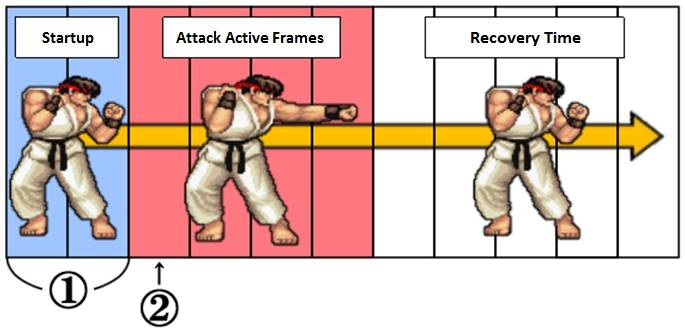Hour 9: The Basics of Attacking: The Basics of Attack Composition
Hello everyone, it's the skill smith, Mr. Bug checking in.
In today's lecture I'd like to cover the basic framework of attacks.
First, let's take a closer look at what elements make up an attack action.
The Attack Process
There are 3 parts to an attack.
1 Startup
2 Attack Active Frames
3 Recovery Period
 This is how an attack is carried out.
This is how an attack is carried out.
It's possible for 1 attack to have multiple attack active frames, but the general flow is basically the same. We'll get into more details about that later.
Startup
The time period from when the attack starts, up until the active frames begin, is called "startup." The fewer startup frames there are, the faster the attack will come out. Attacks with fast startup usually cannot be beaten, so it's okay to think in terms of fast = strong.
Attack Active Frames
The time during which the attack motion has a hitbox is called the "attack active frames." You can also refer to this period as just "active frames" or "active." In this column I'd like to use the notation "active frames."
Unlike the startup, the idea of "longer = better" doesn't apply here. This ties into the next point of discussion, "recovery," but this is something I'd like to go more in-depth with in a later lecture.
For projectiles such as the Hadoken, your character will not have a hitbox - rather, you will fire a projectile that contains a hitbox. So the concept of "active" frames doesn't neatly apply. In terms of your character, the fireball will come out after however many frames are needed for startup, and then your character will go into recovery, which is the next area to address.
Recovery
"Recovery period" refers to the period after the active frames have ended, until your character can move again. Simply put, it's the time when you're open to attack. This can also be referred to as "recovery time" or just "recovery."
Like the startup, shorter is better, so in general you can think that short recovery = strong. However if we look at the attack as a whole, including the active frames, that will start to influence the strength of the move.
Attacks with Multiple Hitboxes
As I mentioned above, there are attacks that have multiple hitboxes. In those cases, it's possible to have no hitbox between the active frames, where you are vulnerable to attack.
 This is a gap between the active frames.
This is a gap between the active frames.
We don't have a name in particular for this gap. Just that you're open, vulnerable, however you want to call it.
Even if there's a gap in the active frames, the basic flow of startup -> active frames -> gap -> active frames -> recovery is unchanged.
Numerical Values & Counting Startup Frames
Note: We're starting to get deeper into advanced topics, but I feel like this is a good place to explain the following topics. It's okay to look at it lightly for a first-time viewing.
The aspects of startup, active frames, and recovery in an attack are often expressed in numerical frame values. Here I'd like you to gain an understanding of the concept, and then when you're playing a game, you can look things up as necessary. There are plenty of things relating to frame data that are not being discussed here.
For active frames and recovery, the number given is simply the number of frames of duration. However for
startup, there are two different ways to approach it.
1 The number of frames until the active frames begin
2 The frame number at which the active frames begin
That's probably pretty difficult to understand. To explain it another way...
1 The number of frames
until the active frames begin.
This is duration, same as the active frames and recovery.
2 The frame
at which the active frames begins.
This is not duration, but rather a fixed point in time.
As 1 is the duration and 2 is the starting point, there will always be a difference of 1 between these numbers, and 2 will always be the higher value.
 1 is the duration and 2 is the starting point.
1 is the duration and 2 is the starting point.
It'll help to pay attention to sentence structure. For 1, the sentence will usually go "starts up in ___ frames," while for 2 you'll hear "starts up on the ____th frame."
You may be thinking - well, since active frames and recovery are expressed in duration, why don't we stick to the same standard for startup as well? That makes sense, but lately, we've mostly been using the 2 method of expressing startup.
The reason for this ties into the concept of recovery, and is due to the more widespread usage of frame data. For example, if you connect an attack that leaves you at a 3-frame advantage, and you want to use that advantage to connect another attack, using the 1 method means you have to think of a move that has a startup of 2 frames. However using the 2 method means you think of a move with a startup on the 3rd frame. Dealing with the same number makes things easier to think about. Use a 3-frame startup move to connect during 3-frame advantage. I'll explain more about this in a later lecture.
As a reference, if you want to express the image above in terms of frames and numbers, it'll look like this...
1 Startup 2/Active 4/Recovery 5
2 Startup 3/Active 4/Recovery 5
Review
Let's review what we've covered so far.
The three parts of an attack are the startup, active frames, and the recovery.。
...And that's it. There are only three parts, but each is extremely important, so be sure you have a good understanding of them.
Now that we've gotten into attacking, you can get a better appreciation for how this all ties into a battle. By increasing your understanding of these concepts, you'll be able to better understand what's going on even when just watching a battle, and subsequently better enjoy watching.
See you again soon!

Writer

























 PlayStation および
PlayStation および
























